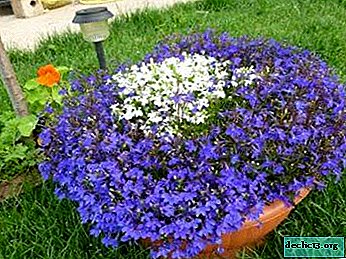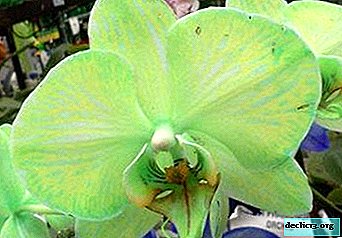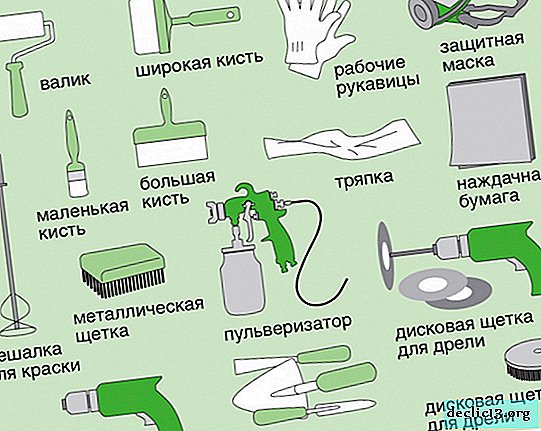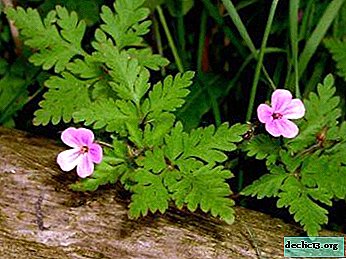What are thrips and how to deal with them if they appeared on orchids?
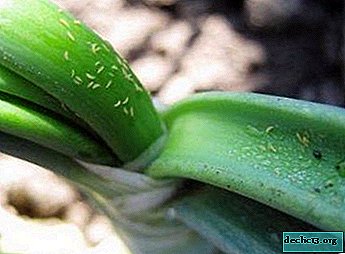
An orchid can be attacked by pests such as thrips. There are several varieties of thrips, we will consider them below.
These small bugs are quite dangerous for a delicate tropical plant, because they feed on its juices. As a result, leaves are damaged, buds dry and fall, the root system of the plant is sick.
We will talk about how to prevent these attackers from appearing, as well as methods of dealing with them, in this article. We also recommend that you watch a useful and informative video on this topic.
What are these insects?
In another way, thrips are also called bubbly or fringed.. They first received a scientific description in the 18th century. These are miniature insects whose elongated body does not exceed 0.5 - 1.5 millimeters in length. (It is very rare to find bubbly up to 1.5 centimeters in size, but such species are found exclusively in tropical forests.)
ATTENTION! Nowhere to hide from these insects, because they are common on all continents. In Russia, there are more than three hundred types of thrips.Kinds
We list only the most basic and numerical subspecies:
- Omnivorous.
- Western floral (aka Californian).
- Tobacco.
- Onion.
- Rosany.
How do they look and what are they dangerous?
The fact that these insects are tiny, we have already said. Thrips are usually gray, black or brown.. Paws very short with vesicular outgrowths. It is thanks to this property that the vesicles are called. Although the wings are present, these parasites cannot fly.
The exception is bread thrips, which have the ability to fly from one field to another in whole swarms. Thrips have several stages of development. At the larval stage, the fringed winged wings are painted gray or beige.
Settling on the green part of orchids, fringe-winged animals suck out juice from them, and therefore deprive them of the ability to photosynthesis. This process is the key to plant life support. Also, flower buds themselves can attack thrips. Because of these parasites, the flowers are deformed, covered with small brown dots, and then completely disappear.
Photo
Next, you can see the photo thrips on orchids:


How to detect them?
On leaf blades, feces of thrips are rarely seen. Due to the fact that these insects suck out the juice from the leaves, the empty space is filled with air and acquires a metallic color. As a result, these airy spots turn brown, and sometimes almost black. This indicates infection with a fungal infection due to the fault of the vesicles.
Why do vesicles appear in flower crops?
Thrips are attacked by orchids that are planted in the wrong soil.. In particular, in a land in which there is too much moss. Sometimes inexperienced gardeners cover the entire surface of the soil with moss, which makes it difficult to circulate air in a flower pot. Therefore, moss should be removed from the surface altogether. Also, thrips can relocate from a newly arrived plant. If you just bought a new orchid, it is better to arrange for it at least a month quarantine and carefully monitor it. So you protect the remaining plants from infection.
How to get rid?
From Californian

Any chemicals are harmful to the human body. Therefore, after treating them with plants, ventilate the room, and before that try not to be in the room.
The difficulty with this type of insect is that they often hide in buds. Therefore, flower growers notice even when this thrips has multiplied significantly and laid a sufficient number of eggs. In addition, this parasite on the American continent has received good immunity to many chemicals. Therefore, the struggle in this way is very complicated. But still we will name everything Possible methods of dealing with a Californian:
- Mechanical. The affected plant can be covered with a thin net with small holes. To enhance the result, hang the same net on windows and doors. And you can also set traps for insects.
- Agrotechnical. Keep an eye on the appearance and general condition of the orchid. If you notice an invasion of California thrips at the initial stage, then you will get by simply removing the affected areas.
- Chemical. You can’t do without insecticides. Choose the highest quality drugs (for example, fitoverm, vertimek, agravertin) that can be used with an interval of 3-5 days. The course of treatment usually lasts about two weeks.
- Biological. Special ticks and bedbugs, which are sent to fight thrips, have been bred. However, this method does not guarantee a one hundred percent victory over the bubbly. Another disadvantage of this method is that ticks and bugs eat only larvae. Thus, adults remain and lay their eggs again.
- Folk. Here you will be helped by the infusion of black-browers (fill a container full of flowers with half full boiling water and let it brew for 48 hours) or a decoction of medicinal dandelion (pour about 20-4 grams of dandelions with a liter of boiling water and leave for three hours).
Tobacco treatment

In this case, you can also list several methods:
- Agrotechnical. Watering should be regular and plentiful. The soil should be loosened and inspected as often as possible for tobacco thrips. If the orchid will be outdoors in the warmer months, avoid the presence of various weeds, as well as vegetable crops, especially onions, next to it.
- Biological. Again predatory ticks and bugs will help. Up to five hundred female predators are required to be planted per plant.
- Chemical. To treat the affected orchid, such means are suitable: “Aktara”, “Fufanon” (dilute one ampoule per 1000 ml of water), “Commander Maxi” and others. Use these funds strictly according to the instructions and not more than once every seven days.
- Folk. Make a decoction of onion peel. To do this, fill the four-liter container with half husk and pour boiling water to the top. Set aside for a couple of days, and then add laundry soap.
How to deal with American?

- Chemical way. Treat your orchid with insecticides. Suitable "Karate" (0.5 milliliters per 2 liters of water), Confidor "(this means do not spray the orchid, but watered the soil)," Karfobos "(you need to dilute 15 grams into two liters of liquid), as well as" Intavir "(one dissolve the tablet in ten liters of water).TIP! A single treatment will not help, since it does not immediately kill all the larvae. Therefore, be sure to resort to reprocessing.
- Biological method the same as in the fight against other types of thrips.
- Folk way. You can apply an infusion of tomato leaves (pour 40 grams of dried leaves in a small volume of boiling water and let it brew for a couple of hours) or a tobacco broth (put 80 grams of tobacco in one liter of water and insist for 24 hours, then strain it and pour an additional two liters water).
From dracenaceae

- In biological terms, predatory mite bugs will come to our aid again.
- To chemicals, you can add a relatively inexpensive tool called Fastak, which, according to the manufacturers, effectively destroys not only adults, but also larvae.
When processing with chemical solutions, make sure that the drug gets into all parts of the plant, including buds, both in the sinuses and under the leaves.
- Folk remedies. The infusion of celandine will help. To prepare it, you can take both fresh and dried grass (fresh - 300 grams, dry -100) and pour it all with a liter of water. Put in a dark room for infusion for 24 hours.
From black

The biological and chemical methods are absolutely identical to the previous ones.. You can add only new items to folk methods:
- A decoction of orange bark. 150 grams of peel + 10 grams of red pepper + 80 grams of millennia + clove of garlic. All this boil for 15 minutes. Then allow to cool, and then strain. With this tool, the root system is processed directly.
- In order not to spray the flowers, you can take chopped garlic, turpentine and place together with the plant in one plastic bag. Allow to stand for three or four hours.
Most folk remedies will only help if the number of thrips is not very large. After processing by any means, wipe the sheet plates, since all preparations form a film that prevents photosynthesis.
Infection prevention
- Thrips love dry air and soil. Therefore, regularly moisturize both the first and second.
- Inspect your beauties more often, especially from the back of leaf plates and in buds. In the early stages of reproduction and in small quantities, thrips are easier to kill.
- Do not forget about the undoubted benefits of the soul. (Put the orchid in the bathroom and pour it from the shower, then wait until the water drains and return to its original place).
- Set sticky traps even for prevention. They will help you spot parasites in a timely manner.
- Quarantine new plants and do not place them next to old ones until you are sure that there are no pests. In order to limit the propagation of thrips, isolate the infected plant immediately.
- The soil in the purchased orchids is either immediately replaced, or punctured in the oven, or held in a freezer for at least two days. Then all existing insects will be destroyed.
- Loosen the soil more often to allow air to circulate well.
Conclusion
Perhaps these are all the recommendations and advice that we would like to share with you today. We hope the article will be useful to you, and you can help your beauty. Remember to choose one of the thrips control methods.. You can only connect the mechanical method with others, but in no case chemical with the folk.





